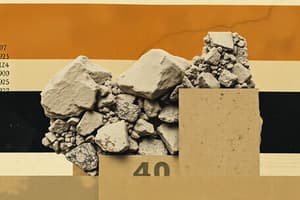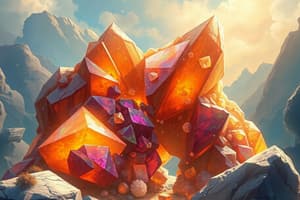Podcast
Questions and Answers
What are the five conditions that a substance must satisfy in order to be a mineral?
What are the five conditions that a substance must satisfy in order to be a mineral?
- Crystalline Solids, Natural and Organic, Variable Chemical Composition, Physical Properties, Regular arrangement of atoms and molecules
- Amorphous Solids, Natural and Inorganic, Definite Chemical Composition, Physical Properties, Regular arrangement of atoms and molecules
- Amorphous Solids, Synthetic and Organic, Variable Chemical Composition, Chemical Properties, Random arrangement of atoms and molecules
- Crystalline Solids, Natural and Inorganic, Definite Chemical Composition, Physical Properties, Regular arrangement of atoms and molecules (correct)
What are the physical properties used to identify minerals?
What are the physical properties used to identify minerals?
- Luster, Hardness, Color and Streak, Cleavage, Fracture, Magnetism (correct)
- Transparency, Conductivity, Ductility, Malleability, Brittleness
- Density, Viscosity, Elasticity, Surface Tension, Refractive Index
- Acidity, Alkalinity, Solubility, Corrosiveness, Reactivity
Which mineral is known for its use in talcum powder and as a lubricant?
Which mineral is known for its use in talcum powder and as a lubricant?
- Calcite
- Talc (correct)
- Hematite
- Galena
What type of mineral is known for its metallic luster and is a source of lead?
What type of mineral is known for its metallic luster and is a source of lead?
Which type of mineral has a flaky texture and is commonly used in pencil lead and as a lubricant?
Which type of mineral has a flaky texture and is commonly used in pencil lead and as a lubricant?
Flashcards are hidden until you start studying




